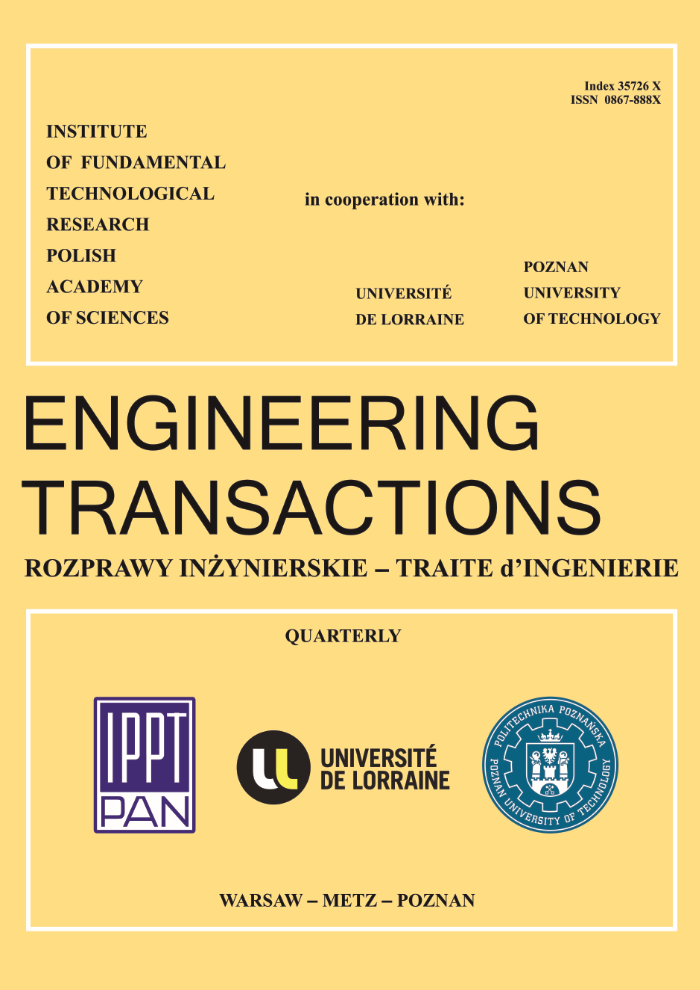A Simple Single Specimen Method for Measuring the Fracture Surface Energy of Rubber Materials
Abstract
In this investigation, particular attention is paid to the generalized theory of fracture mechanics developed by Andrews and based on the spatial strain energy density distribution W in the case of an infinite lamina. A numerical analysis using a finite element method brings out some serious shortcomings in the fundamental equation of this theory when dealing with laboratory specimens of finite dimensions. It is proven that the $J$ integral derived from this equation has no physical meaning. We have proposed an alternative expression of W which leads to a simplified $J$ integral requiring measurements on one specimen only.Keywords:
fracture, rubber, J integral, nonlinearity, finite elementReferences
1. J.R. RICE, Mathematical analysis in the mechanics of fracture, H. LIEBOWITZ [Ed.], Academic Press, 2, 191–311, London 1968.
2. N. MING WANG, Finite element analysis of cut growth in sheets of highly elastic materials, Int. J. of Structures, Pergamon Press, 9, 1211–1223, 1973.
3. R.M.V. PIDAPARTI, T Y. YANG and W. SOEDEL, A plane stress finite element method for prediction of rubber fracture, Int. J. of Fracture, 39, 255–268, 1989.
4. E.H. ANDREWS, A generalised theory of fracture mechanics, J. Mater. Sci., 9, 887–894, 1974.
5. H. GHFIRI, M. NAIT ABDELAZIZ and G. MESMACQUE, Experimental determination of J on rubbery materials: influence of finite dimensions, Engng. Fracture Mechanics, 44, 681–689, 1993.
6. N. AIT HOCINE, M. NAIT ABDELAZIZ, H. GHFIRI and G. MESMACQUE, Evaluation of the energy parameter J on rubber-like materials: comparison between experimental and numerical results, Engng. Fracture Mech., 55, 6, 919–933, 1996.
7. N. AIT HOCINE, M. NAIT ABDELAZIZ and G. MESMACQUE, Experimental and numerical investigation on single specimen methods of determination of J in rubber materials, Int. J. of Fracture, 94, 321–338, 1998.
8. M.H. SHAROBEAM and J.D. LANDES, The load criterion and methodology in ductile fracture mechanics, Int. J. of Fracture, 47, 81–104, 1991.
9. J.A. BEGLEY and J.D. LANDES, The J integral as a fracture criterion, in fracture toughness, ASTM STP, 514, 1–23, 1972.
10. V.D. WATWOOD, The finite element method for prediction of crack behaviour, Nucl. Engng. Des., 11, 323–332, 1969.
11. H.L. OH, Mechanics of crack growth, ASTM STP, 590, 104–114, 1976.
2. N. MING WANG, Finite element analysis of cut growth in sheets of highly elastic materials, Int. J. of Structures, Pergamon Press, 9, 1211–1223, 1973.
3. R.M.V. PIDAPARTI, T Y. YANG and W. SOEDEL, A plane stress finite element method for prediction of rubber fracture, Int. J. of Fracture, 39, 255–268, 1989.
4. E.H. ANDREWS, A generalised theory of fracture mechanics, J. Mater. Sci., 9, 887–894, 1974.
5. H. GHFIRI, M. NAIT ABDELAZIZ and G. MESMACQUE, Experimental determination of J on rubbery materials: influence of finite dimensions, Engng. Fracture Mechanics, 44, 681–689, 1993.
6. N. AIT HOCINE, M. NAIT ABDELAZIZ, H. GHFIRI and G. MESMACQUE, Evaluation of the energy parameter J on rubber-like materials: comparison between experimental and numerical results, Engng. Fracture Mech., 55, 6, 919–933, 1996.
7. N. AIT HOCINE, M. NAIT ABDELAZIZ and G. MESMACQUE, Experimental and numerical investigation on single specimen methods of determination of J in rubber materials, Int. J. of Fracture, 94, 321–338, 1998.
8. M.H. SHAROBEAM and J.D. LANDES, The load criterion and methodology in ductile fracture mechanics, Int. J. of Fracture, 47, 81–104, 1991.
9. J.A. BEGLEY and J.D. LANDES, The J integral as a fracture criterion, in fracture toughness, ASTM STP, 514, 1–23, 1972.
10. V.D. WATWOOD, The finite element method for prediction of crack behaviour, Nucl. Engng. Des., 11, 323–332, 1969.
11. H.L. OH, Mechanics of crack growth, ASTM STP, 590, 104–114, 1976.






